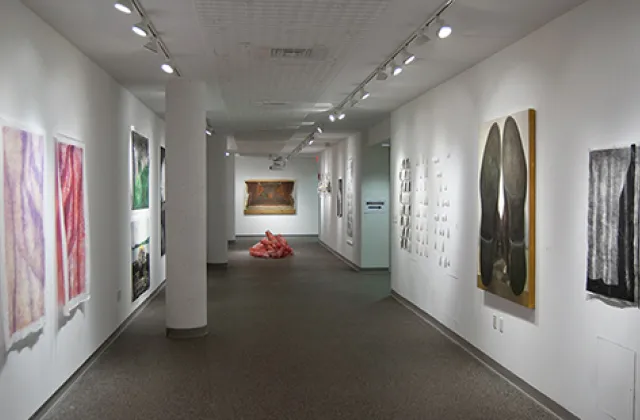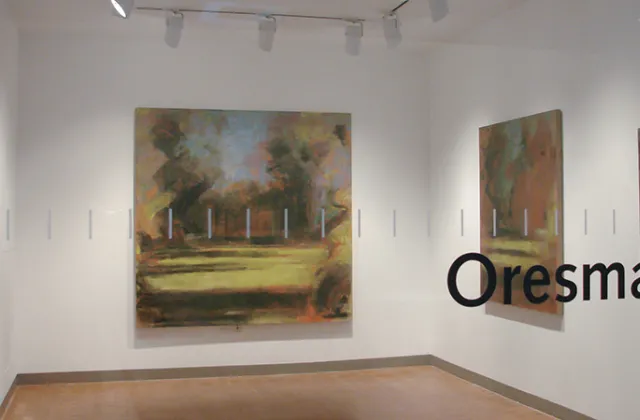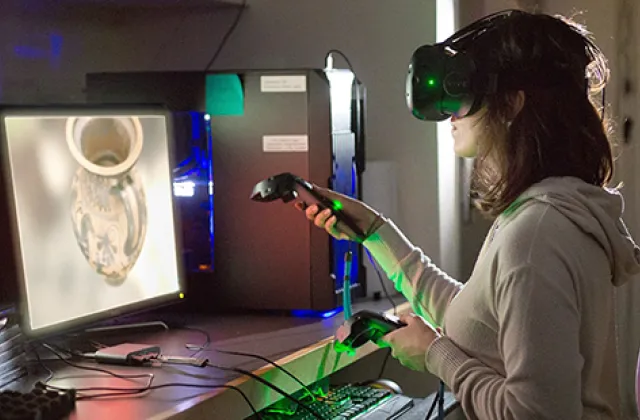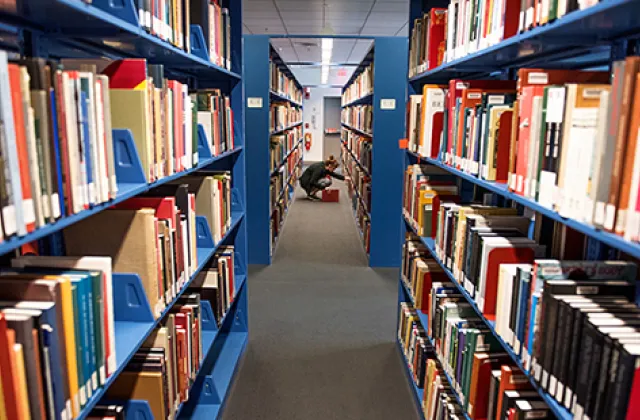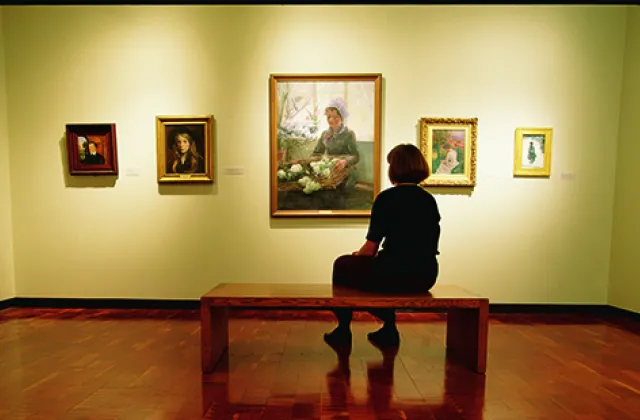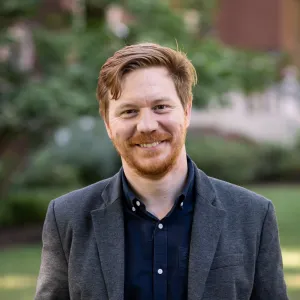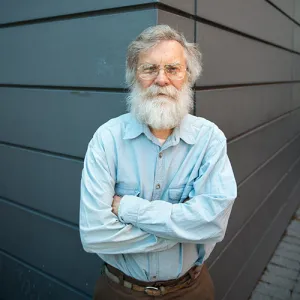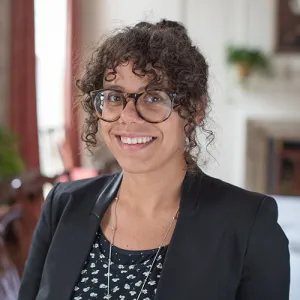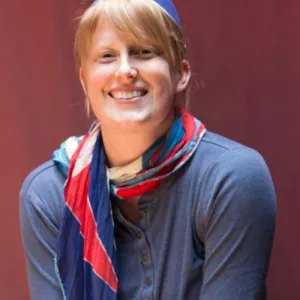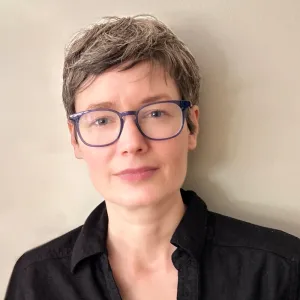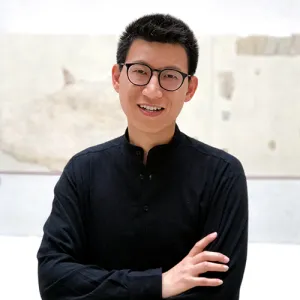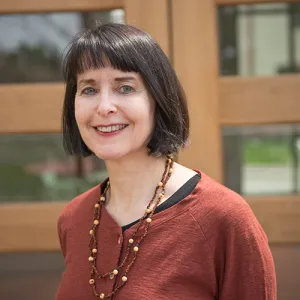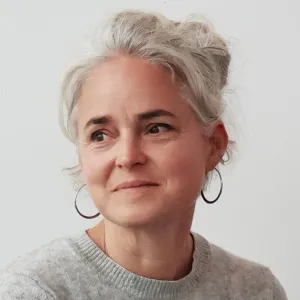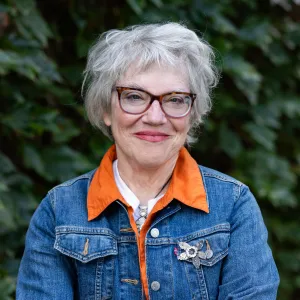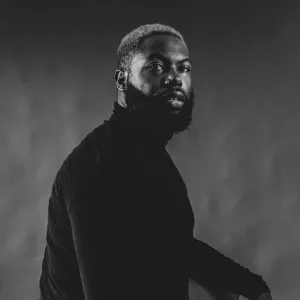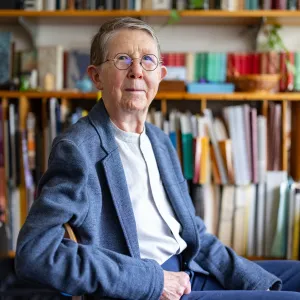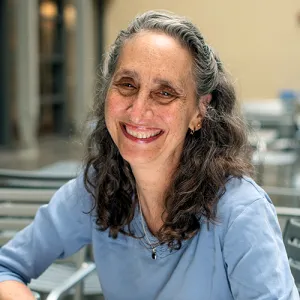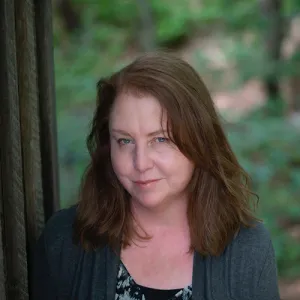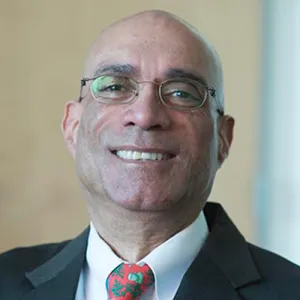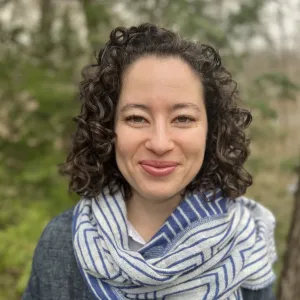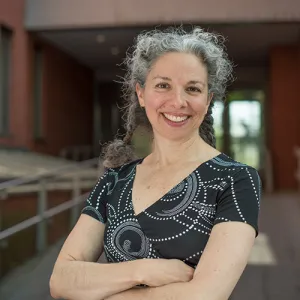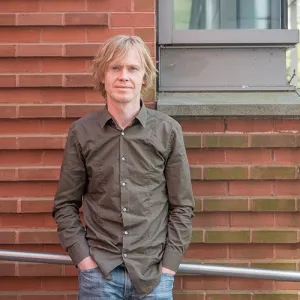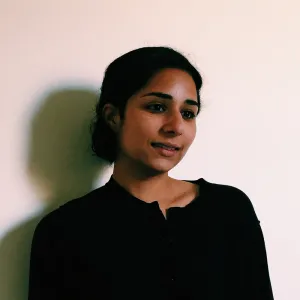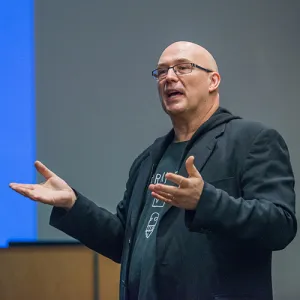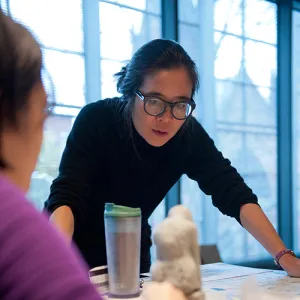Art
The Smith art department embraces the history of art, studio practice and architecture. In all three arenas, we are committed to cultivating visual literacy and to understanding artistic production in different cultures throughout time and in our own media-saturated present.
Art majors have gone on to careers as artists, scholars, architects, landscape architects, art librarians, educators, visual resource specialists, conservators, preservationists, curators and gallerists. They have also become editors, entrepreneurs, lawyers and doctors. Whether they major in the field or take a course or two, students have found that informed visual thinking, no less than the pleasure of aesthetic experience, continues to enrich their lives and their work.
Fall Senior Exhibition: Potluck Sleepover
Jannotta Gallery | On view December 5, 2025-February 12, 2026
A culminating group exhibition by senior studio art majors.
Contributing artists include: Rebecca Aware, Ilana Diddams, Tori Gomez, Veda Hedgepeth, Rowan Howe, Sula Johnson, Joan Kobayashi, Lan Kung, Nikté Lopez-Aleshire, Isa Norris-Howard, Eloise Silver Van Meter, Risa Watanabe
Requirements & Courses
Goals for Majors in Art
All graduating art majors and minors will:
- develop familiarity with original works of art and/or architecture and with research tools appropriate for the discipline, including print scholarship, online databases, and various reference materials;
- communicate their ideas effectively in written, oral and (as appropriate) material form, including public presentations that rely upon the display of visual images or artwork;
- engage a range of disciplines in their work, in the spirit of a liberal arts education.
Art studio and architecture majors and minors will:
- demonstrate fluency in practices or techniques in the current field of practice for at least one medium (e.g, painting, installation, photography, digital media);
- demonstrate proficiency in an extensive and pertinent vocabulary for describing their own work and the art historical antecedents with which it shares relationships;
- demonstrate familiarity with professional practices and global perspectives within the cultural landscape of contemporary art;
Assessment (majors and minors): Students will be assessed through periodic faculty and peer critiques of their work and reviews of their written and oral abilities.
Assessment (majors only): Students will create a body of work for final exhibition that results from deep engagement in the process of making and demonstrates an awareness of the contemporary and historical context in which the work exists. This work will be evaluated through peer, faculty, and external critique.
Students will also complete the major with a professional-level, documented portfolio of their work, including both visual and written materials.
Art history majors and minors will:
- learn to read original objects, architectural settings, and written scholarship analytically and synthetically;
- demonstrate familiarity with the different ways that spaces, monuments, and objects have intersected with lived and imagined experiences throughout history and the world over;
- demonstrate expertise in self-directed research, including fluency with a range of methodologies and debates across the discipline.
Assessment: Students will be assessed in classes, through faculty reviews of their written and oral abilities.
Students will also complete a capstone research seminar that results in a sustained piece of original research, presented in oral form and a paper of ca. 15 pages, to be evaluated by the faculty.
Art History Major
Courses in the history of art are divided into areas that reflect breadth in terms of both geography and chronology.
Requirements
Ten courses
- As a gateway to the major, students may take either ARH 110, normally completed by the sophomore year, or a first-year seminar taught by an art history faculty member.
- One course in studio art
- ARH 190: Art History, normally taken by the junior year.
- Six courses in the history of art and architecture at the 200 and 300 levels.
- Students are expected to take a mix of lectures, colloquia and seminars, sequenced in consultation with the major adviser.
- These courses should address a range of methodologies, time periods and geographies (e.g. Asia, Europe, North America, Latin America, Africa, etc.).
- For different methodological approaches, students should take courses with a range of faculty members.
- The six courses should include two that focus on material created before 1850. Note that there can be overlap, so for instance a course on Buddhist grottoes could serve as both a class on material before 1850 and on Asia.
- In consultation with the adviser, these six courses may include one from a related discipline or a second studio course.
- ARH 390, normally taken in the senior year.
- Students entering Smith with a 5 on the AP art history exam may choose to be exempted from ARH 110, replacing it with another art history course at the 200 level or above.
- No course counting toward the fulfillment of the major or minor may be taken for an S/U grade.*
- Courses associated with a concentration (such as IDP, MUX, etc.) cannot be counted toward the completion of the art major.
Studio Art Major
Requirements
Eleven 4-credit courses
- One 100-level studio art course: ARS 162, ARS 163 or ARS 172 (Note that certain upper-level courses indicate specific 100-level course prerequisites.)
- ARH 110
- One course with contemporary emphasis, relating to art history, visual studies or film and media studies, to be chosen in consultation with adviser.
- One additional art history course at the 200 level or 300 level
- Five additional 4-credit studio art courses
- One course may be at the 100 level
- Students may work across media areas but must consult with their adviser to take a series of courses (usually three) to reach the advanced level in at least one of the following. Each area is sequenced differently but will require at least one 300-level course.
- drawing
- digital media
- graphic arts (printmaking or typography)
- installation
- painting
- photography
- sculpture
- ARS 385
- ARS 399
- Students who complete their degree requirements in the fall semester should take ARS 399 in their junior year. All other students should take ARS 385 and ARS 399 in their senior year.
- Students entering Smith with a 5 on the AP art history exam may choose to be exempted from ARH 110, replacing it with another art history course at the 200 level or above.
- No course counting toward the fulfillment of the major or minor may be taken for an S/U grade.*
- Courses associated with a concentration (such as IDP, MUX, etc.) cannot be counted toward the completion of the art major.
Declaring a major in studio art
A student may declare a major in studio art any time after completing the introductory (100-level) studio art requirement and one additional studio art course. Prior to declaration, students must complete a portfolio review, scheduled each semester prior to the advising period. Students who receive a negative evaluation will be encouraged to take an additional studio course or courses and resubmit their portfolio at a subsequent review time. Students who receive a negative evaluation may resubmit their portfolios in subsequent reviews up to and including the last portfolio review available during their sophomore year. These students will be offered suggestions for strengthening their portfolios through additional studio coursework in the same or other media represented in the portfolio. The additional studio courses will count toward fulfilling the major requirements.
Mapping the major in studio art
Upon receiving a positive portfolio evaluation, a student should select and meet with a studio art adviser to discuss the student’s interests and studio work to date and to select a media from those listed above. The student and adviser may design a sequence of studio courses that draws from several areas of focus.
Architecture and Urbanism Major
Requirements
Twelve courses
- ARH 110
- One 100-level studio art course: ARS 162, ARS 163 or ARS 172
- Two introductory architectural design studio courses: ARS 280 and ARS 281
- One advanced architectural design studio course: ARS 380 or ARS 381
- One studio art course in another medium
- Three 200-level or 300-level art history courses focusing on the built environment
- One course with a focus on pre-1850
- One course with a focus on post-1850
- One elective
- Two architecture-focused electives selected with guidance from the major adviser
- One art history research-focused seminar with final paper focusing on the built environment, to be taken at Smith
It is recommended that a student contemplating application to a graduate program in architecture take at least one semester of physics and at least one semester of calculus, after consultation with the student’s major adviser.
Honors
Requirements and Presentations
All candidates will present their work to the department, in a public presentation, in late April or early May. Guidelines and further details can be found on the department website. Students planning to major or to do honors work in art will find it valuable to take courses in literature, philosophy, religion and history in the first two years. A reading knowledge of foreign languages is useful for historical courses. Courses may require one or more trips to Boston, New York or other places in the vicinity to study original works of art.
Art History Minor
Designed for students who, although they major in another department, wish to also focus on the history of art. With the assistance of their advisers, students may construct their minor to be as specific or comprehensive as they desire within the skeletal structure of the requirements.
Requirements
Six courses
- As a gateway to the minor, students make take either ARH 110, normally completed by the sophomore year, or a first-year seminar taught by an art history faculty member
- ARH 190
- Four courses in the history of art and architecture:
- Students are expected to take a mix of courses sequenced in consultation with their adviser.
- These courses should address a range of methodologies, time periods, and geographies (e.g. Asia, Europe, North America, Latin America, Africa, etc.).
- For different methodological approaches, students should take courses with a range of faculty members.
- The four courses include one that focuses on material created before 1850. Note that there can be overlap, so for instance a class on Buddhist grottoes could serve as both a class on material before 1850 and on Asia.
- The four courses should include two at the 290 level and above.
- The four courses may include one studio art course.
Studio Art Minor
Designed for students who wish to focus on studio art, although they are majors in another department. With the assistance of a minor adviser, a student may construct a minor with primary emphasis on one area of studio art or may design a minor that draws from several areas of concentration.
Requirements
Six 4-credit courses
- ARS 162, ARS 163 or ARS 172
- Three courses at the 200 level
- One course at the 300 level
- One elective in studio art
Architecture and Urbanism Minor
Designed for students who wish to focus on architecture, although they are majors in another department. This minor seeks to introduce students to the history, design and representation of the built environment.
Requirements
Six courses
- ARS 162, ARS 163 or ARS 172
- ARS 280 or LSS 250
- ARS 281 or LSS 255
- Two art history courses at the 200 level or 300 level focusing on the built environment
- one course with a focus on pre-1850
- one course with a focus on post-1850
- ARH 110
Graphic Arts Minor
Graphic arts seeks to draw together the department’s studio and history offerings in printmaking and typography into a cohesive unit.
Requirements
Six courses
- ARS 163
- ARH 247 or a topic of ARS 268
- Three courses in studio art from this list: ARS 269, ARS 272, ARS 275, ARS 372 or ARS 376
- ARS 372, ARS 376 or a continuation of one medium
Course Information
The following studio courses are repeatable with different course content and instructor, for a maximum of 8 credits: ARS 264, topics of ARS 268, ARS 362, ARS 362
, ARS 363
, ARS 364
, topics ARS 366, ARS 372
, ARS 374
, ARS 376
, ARS 383
, topics of ARS 384.
Art history ARH 290 topics are repeatable with different course content for a maximum of 16 credits.
Advanced 200-level Colloquia Including topics of ARH 290, address methodological and theoretical questions as well as the histories of particular cultures, objects and moments. All of these colloquia involve sustained discussion and independent research, and require at least one 200-level art history course as a prerequisite. Enrollments limited to 18.
Seminars require advanced-level research. Students are expected to bring to class a solid and relevant background in the general field and period of study. All seminars require an oral presentation and a research paper. Enrollments limited to 12.
Studio Courses Core studio materials (such as ink, plaster or chemicals) are supplied to students of studio courses. Students are responsible for the purchase of additional supplies required for individual projects. The department reserves the right to retain examples of work done in studio courses. All studio courses require extensive work beyond the scheduled class hours. Please note that all studio art courses have limited enrollments.
Courses
ARH 110 Art and Its Histories (4 Credits)
This course explores how art and architecture have profoundly shaped visual experiences and shifting understandings of the past and present. Featuring different case studies, each section includes work with original objects, site visits and writings about art. Unifying themes include: (1) materials, techniques and the patterns deployed to create space; (2) the design, function and symbolism of images and monuments; (3) artistic production and its relation to individual and institutional patronage, religion, politics and aesthetics; (4) issues turning on artists’ fame versus anonymity and uniqueness versus reproducibility; and (5) cross-cultural exchanges. Enrollment limited to 25. Arts; Historical Studies
Fall, Spring
ARH 190 Colloquium: Art History: Theories, Methods, Debates (4 Credits)
The meanings ascribed to art and architecture from any culture or period turn upon the interpreter’s preoccupations and methods. This course examines contemporary debates within the discipline, locating them within the field’s own history. The class asks: what kinds of knowledge do historians of art and architecture produce and legitimize? What kinds of questions do they ask, and what means do they use to answer them? Considering art and architectural history as a living field, the focus falls on recent scholarship, with an eye to the dynamic ways in which it builds on and/or departs from the history of the discipline. Prerequisites: ARH 110 or a first-year seminar taught by a member of the department. Enrollment limited to 18. Arts
Fall, Annually
ARH 201/ POR 201 Brazilian Art Inside and Out (4 Credits)
Offered as POR 201 and ARH 201. This course serves as an introduction in English to contemporary and modern Brazilian art. Course materials and class discussions address such topics as public vs. private art spaces, national vs. global identities, the role of art as agency for social change and as site of memory, activism, resistance and transformation. Arts
Fall, Variable
ARH 204 Inkas, Aztecs and Their Ancestors (4 Credits)
What is antiquity in the Americas? To explore this question, this class focuses upon visual cultures and urban settings from across the Americas. Emphasis rests upon recent research especially about the Inka, the Aztec and their ancestors, but the course also studies the current debates in art history and archaeology. Discussions include: sacrifice and rulership, representations of human and deified beings, the symbolic and economic meanings of materials, and the ethics of excavation and museum display. Case studies include architectural complexes, textiles, ceramics and sculpted works from Peru, Mexico, the Caribbean and the U.S. Southwest. Counts for ARU. Arts; Historical Studies
Fall, Spring, Variable
ARH 207 Translating New Worlds (4 Credits)
This course asks how travel to and through the New World was imagined, described and lived by Indigenous residents as well as those who came to the Americas from across the Atlantic and the Pacific oceans. The focus rests upon the ways in which geographies, anthropologies, material objects, and pictorial and written records shaped colonial ambitions and experiences. Among the objects the class considers: books and painted images, dyes and metals, feathers and urban buildings. Case studies are drawn from across the Americas, including Canada, Mexico, Ecuador, Haiti and the United States. The class also discusses contemporary cultural practices that seek to explain, interpret and redress colonial encounters and settlements in the Americas. Group A, Counts for ARU. Arts; Historical Studies
Fall, Spring, Variable
ARH 212 Ancient Cities and Sanctuaries (4 Credits)
This course explores many different aspects of life in the cities and sanctuaries of the ancient Near East, Egypt, Greece, Etruria and Rome. Recurrent themes include urbanism, landscapes and patterns of worship, including initiation, sacrifice and pilgrimage. The class probes how modern notions of the secular and the sacred influence interpretation and how sometimes the seemingly most anomalous features of the worship of Isis or of the juxtaposition of commercial and domestic space within a city can potentially prove to be the most revealing about life in another place and time. Counts for ARU. Arts; Historical Studies
Fall, Spring, Variable
ARH 216 The Art and Architecture of the Ancient Roman World (4 Credits)
From North Africa to Gaul, from the Pillars of Hercules (Straits of Gibraltar) to Asia Minor, the interrelationships of art and power in the visual culture of the ethnically diverse Roman empire, from the first century B.C.E. through the fourth century C.E., are the subject of study. The class also examines works of art from later periods as well as literature and film that structure the perception of the Roman world. Counts for ARU. Arts; Historical Studies
Fall, Spring, Variable
ARH 217/ CLS 217 Greek Art and Archaeology (4 Credits)
Offered as CLS 217 and ARH 217. This course is a contextual examination of the art and architecture of Ancient Greece, from the end of the Bronze Age through the domination of Greece by Rome (ca. 1100-168 BCE) and handles an array of settlements, cemeteries and ritual sites. It tracks the development of the Greek city-state and the increasing power of the Greeks in the Mediterranean, culminating in the major diaspora of Greek culture accompanying the campaigns of Alexander the Great and his followers. The course takes a broadly chronological approach, and the question of a unified Greek culture is stressed. Continuing archaeological work is considered. Arts; Historical Studies
Fall, Spring, Alternate Years
ARH 227 Colloquium: Is This Architecture? (4 Credits)
Is this Architecture? To answer this question, this class considers both traditional forms of Architecture (capital A) and creations that stretch that very concept and definition. Among the issues discussed and debated: how people and communities create spaces to live; enshrine the sacred; build sites of pleasure; and re-work land, water, and civic space in the wake of imperial expansion wars, earthquakes, and floods. Working across cultures, with examples drawn from antiquity to the present, this class highlights global and local perspectives, attending to settings as diverse as 3rd century India, 16th century Peru, and 21st-century Maldives and Great Britain. Counts for ARU. Enrollment limited to 20. Arts; Historical Studies
Fall, Spring, Alternate Years
ARH 231 Medieval Architecture (4 Credits)
To step inside a medieval cathedral is still a profound experience. Nowadays, their majestic heights and elegant forms are objects of quiet contemplation. Yet medieval buildings were seldom still or silent, and their audiences were rarely disinterested observers. This course surveys the architecture of Europe and the Mediterranean between the fourth and the fifteenth centuries. The course explores the development of the distinctive forms of medieval architecture in both the East and the West—from churches and monasteries to mosques, synagogues, cities, and palaces—and how these spaces were activated in contexts of ritual, liturgy, and performance. (E) Arts; Historical Studies
Fall, Variable
ARH 236 Architectures of Collecting (4 Credits)
In what spaces are collections—of art and artifacts, plants and animals, papers and memories—held? What physical spaces have been created to house, preserve, sequester, and display such things? Upon what conceptual and infrastructural practices does collecting depend? To consider these questions, this class focuses on case studies from 1500-present, drawn from across the world: museums of ethnography and racial justice, private houses and public gardens, seed banks and aquaria. In addition, this class addresses the ethical implications of thinking about architecture and collecting—both literally and metaphorically—as joint, codependent endeavors. Counts for ARU. Enrollment limited to 30. Arts; Historical Studies; Literature
Fall, Spring, Alternate Years
ARH 247 Colloquium: The Art and History of the Book (4 Credits)
Will books as material objects disappear in the near future? Or will the book, a remarkably long-lived piece of communication technology, continue to flourish and develop alongside its electronic counterparts? This course surveys the artistry and history of books from the ancient world through medieval manuscripts, hand press books and machine press books, to the digital media of today. Students discover how books were made, read, circulated, and used in different eras, and explore the role they have played over time in social, political, scientific, and cultural change. The course involves extensive hands-on work with books and manuscripts from across the centuries and sustained engagement with current debates about book, print, and media culture. Instructor permission required. Enrollment limited to 12. Arts; Historical Studies
Spring
ARH 250 Building Baroque Europe (4 Credits)
European architectural, urban and landscape design from (precisely) 1537 to about 1750. Specific topics include Tuscany under the first three grand dukes; Rome in the 17th century; France under the first three Bourbon kings; the rebuilding of London after the Great Fire; the significant enlargement or establishment of capital cities (Turin, Amsterdam, Versailles, Stockholm, St. Petersburg, Dresden, Berlin, Vienna); the rise of the English country house; the English landscape garden; and palaces, pilgrimage churches and monastic complexes in Bavaria, Franconia and Austria. Focus throughout on the fundamental interdependence of architecture and society. Counts for ARU. Arts; Historical Studies
Fall, Spring, Variable
ARH 258 The Arts in Eighteenth-Century France (4 Credits)
A study of painting, sculpture, architecture, urban and landscape design, printmaking and the luxury arts in France, from the last years of Louis XIV's reign to the French Revolution. Recurring themes include artists' training and careers; academies, aesthetics and art theory; art criticism and the viewing public; collecting and display; patronage; and the relationship of art to politics, literature and science. France's pacesetting role in contemporary art is explored by looking beyond its borders to other courts--among them Bourbon Naples, some German-speaking principalities, Great Britain, Russia, Spain and Sweden--and to the French Atlantic world. Counts for ARU. Arts; Historical Studies
Fall, Spring, Variable
ARH 272 Revolution, Industry, Empire: The Art of the Nineteenth Century (4 Credits)
The Haitian revolution, Darwin’s On the Origin of Species, the rise of photography: the nineteenth century witnessed the emergence of new ways of seeing, knowing, and being in the world. The course considers the ways art objects and the built environment revealed, constructed, and mediated nineteenth-century life. Students study key case studies, from painting and sculpture to advertising ephemera, to understand significant cultural nodes. Conversations center around the meaningful role objects play in shaping and constructing social experience and key concepts elaborated by nineteenth-century thinkers, such as modernism. The course primarily focuses on Europe and the US. Group B. Enrollment limited to 30. Arts; Historical Studies
Fall, Spring, Variable
ARH 278 Race and Gender in the History of Photography (4 Credits)
This course introduces the history of photography, emphasizing the ways photographs represent, mediate, construct and communicate histories of race, gender, sex, sexuality, intimacy and desire. The class studies a variety of photographic images, from the daguerreotype to digital media, from fine arts photography to vernacular images. Students consider objects that have forged connections among loved ones, substantiated memories or served as evidence, considering critical questions about photography’s relationship to identity, affect, knowledge production and power. The course focuses on race and gender, and also attends closely to photography’s relationship to identity broadly speaking, including class, ability and religion. Enrollment limited to 35. Arts; Historical Studies
Fall, Spring, Variable
ARH 281 Modern, Postmodern, Contemporary (4 Credits)
This course examines global artistic tendencies since 1945 in their art-historical and socio-historical contexts. The class considers such developments as American abstraction and the rise of New York, neo-dada, pop, minimalism, conceptual art, earthworks, the influence of feminism, postmodernism, the politics of identity, conceptions of the site and the institution, global publics and the global culture of art, and the theoretical issues and debates that help to frame these topics. Arts; Historical Studies
Fall, Spring, Alternate Years
ARH 283 Architecture Since 1945 (4 Credits)
This course presents a global survey of architecture and urbanism since 1945, from post-World War II reconstruction and planning, through critiques of modernism, to postmodernism, deconstruction, critical regionalism and beyond. Major buildings, projects, movements and tendencies are examined in their historical, theoretical and rhetorical contexts. Counts for ARU. Arts; Historical Studies
Fall, Spring, Variable
ARH 285pm Topics: Great Cities-Pompeii (4 Credits)
A consideration of the ancient city: architecture, painting, sculpture and objects of everyday life. Women and freed people as patrons of the arts are emphasized. The impact of the rediscovery of Pompeii and its role as a source of inspiration in 18th-, 19th-, and 20th-century art is discussed. No prerequisite. Arts; Historical Studies
Fall, Spring, Variable
ARH 286 History and Theory of Performance Art: Why Did the Performance Artist Cross the Road? (4 Credits)
This class addresses the history and theory of performance art since the 1960s, introducing artists whose work has shaped the field and the issues which have become important in the reception of performance art. Arts; Historical Studies
Fall, Spring, Variable
ARH 288 Colloquium: Techniques in Digital Art History (1 Credit)
This course provides students with a robust set of skills for today’s art historian. With an emphasis on hands-on training using Imaging Center facilities, students complete multiple small projects in digital mapping, digital timelines and other data visualizations, scanning and photography of artworks, documenting artwork with international data standards, creating virtual galleries, 3D scanning and more. Short readings on the application of these methods in current art history scholarship is also assigned. Software includes Google MyMaps, Tableau, Timeline JS, Adobe Photoshop and Lightroom, Artstor/JSTOR Forum, Wordpress, Unity and others. S/U only. Enrollment limited to 12. Arts; Historical Studies
Interterm
ARH 289 Art and Medicine, Late 18th Century to the Present (4 Credits)
This course examines intersections of art and medicine from the late 18th century to the present. Considering a variety of texts and objects, from wax medical models and public health posters to Mona Hatoum’s cell-like sculptures and photographic coverage of the 2014 Ebola epidemic, the course disentangles how medical understandings of the body filter into artistic production and popular thought and vice versa. While course material is primarily from Europe and the United States, the course attends to the ways medical imaginings of the body engage with imperialism and geopolitical boundaries, as well as race, gender, ability, class and sexuality. (E) Arts; Historical Studies
Fall, Spring, Variable
ARH 290am Colloquium: Topics in Art History-Art and Money (4 Credits)
Art and money are inextricably intertwined. This course delves into the ramifications of this relationship in the ways art is valued in the contemporary art market and the consequences for museums, collectors, artists, and the general public. Discussions include artists’ self-fashioning for the market as well as the historical detective work it takes to reveal the practices which have fed this market of limited supply and infinite demand including looting and forgery. These are stories which need to be shared with an ever-wider audience especially in a time when the importance of art to humankind needs reevaluation. Restrictions: ARH 290 may be taken for credit a total of 4 times with different topics. Enrollment limited to 20. Instructor permission required. Arts; Historical Studies
Fall, Spring, Variable
ARH 290ca Colloquium: Topics in Art History-Contemporary Art (4 Credits)
This class examines current issues in contemporary art, suggested by critical debates and significant exhibitions. The class is particularly interested in practices and debates that offer the following: analyses of the global condition of art; demonstrations of the influence of new technologies; reflections on institutional frameworks; excavations of earlier art-historical moments; and accounts of the shifting status of art, artists and audiences in the contemporary public sphere. Prerequisite: One 200-level art history course, or equivalent. Restrictions: ARH 290 may be taken for credit a total of 4 times with different topics. Enrollment limited to 20. Arts; Historical Studies
Fall, Spring, Variable
ARH 290ce Colloquium: Topics in Art History-China in Expansion: Early Chinese Art & Material Culture (20th century BCE-220 CE) (4 Credits)
During the formative periods when the local and global forces simultaneously took actions in shaping Chinese civilization, the functions of images and objects, the approaches to things and the discourses around art underwent significant shifts, not only responding to but also mapping out the "Chinese-ness" in visual and material culture. This course of early Chinese art investigates diverse media bronze vessels, sculptures, murals, textiles, architecture and other visual and material forms in relation to political and military conquest, cross-cultural exchange, the dissemination of ordinary practices and the formation of identities. Key terms and issues for the course include expansion, connection and materiality. Counts for ARU. Restrictions: ARH 290 may be taken for credit a total of 4 times with different topics. Enrollment limited to 20. Arts; Historical Studies
Fall, Spring, Alternate Years
ARH 290cm Colloquium: A Century in Crisis: Modern Chinese Art (1850 - 1950) (4 Credits)
How did Chinese artists respond to a century of national decline, foreign invasion, urban transformation, and revolution? Why were women--both as artists and as visual icons--critical to the remaking of modern China? This course traces the history of modern Chinese art from the final decades of the Qing dynasty through the Republican period, examining a variety of media including painting, printmaking, photography, film, and architecture. The course explores how artists negotiated tradition and modernity, nationalism and colonialism, masculinity and femininity, with a special focus on the representation of women and the emergence of female artists. Restrictions: ARH 290 may be taken for credit a total of 4 times with different topics. Enrollment limited to 20. (E) Arts; Historical Studies
Fall, Spring, Alternate Years
ARH 290cv Colloquium: Topics in Art History-Colonialisms and Their UnMaking: Land, Water, Bodies, Belongings (4 Credits)
How does conquest by foreigners change the ways that images, objects, and environments (built and otherwise) are created and used? How do different forms of colonialism—settler, extractivist, etc.—remake values and thus objects, civic spaces, humans, and other living beings? What kinds of loss does colonization produce, what kinds of resilience? Focusing on recent scholarship, this class addresses these questions, highlighting the 16th–19th centuries. Discussion include: the production of colonial spaces and buildings; exchanges that brought people and objects into contact (and conflict); nationalist museum and archival projects; and current debates about decolonization, repatriation, and reparation. Counts for ARU. Restrictions: ARH 290 may be taken for credit a total of 4 times with different topics. Enrollment limited to 20. Arts; Historical Studies
Fall, Spring, Variable
ARH 290fs Colloquium: Topics in Art History-The Visual Culture of Freed Slaves in the Roman Empire (4 Credits)
Many ancient Roman houses and tombs belonged to freed slaves who had established themselves and their families in the world. Assessed through the lens of elite authors who disparaged freed people, these monuments have often been judged as lesser, imperfectly emulating lost aristocratic models. On the contrary, as a close reading of these houses and tombs themselves demonstrate, freedmen and freedwomen celebrated their transformation from being things to being persons of means by finding visual means to celebrate their industry, their wealth, their ambition and their identification with mythological figures who had once been enslaved. Restrictions: ARH 290 may be taken for credit a total of 4 times with different topics. Enrollment limited to 20. Arts; Historical Studies
Spring, Alternate Years
ARH 290hp Colloquium: Topics in Art Historical Studies-History of Printmaking (4 Credits)
This class covers the history of prints from the 15th century through the present day, mainly in the West. The course follows a chronology that allows students to understand the lineage of prints through time and to gain a familiarity with notable practitioners, the aim is to understand printmaking in the context of broader currents in art, culture, and technology. Restrictions: ARH 290 may be taken for credit a total of 4 times with different topics. Enrollment limited to 20. (E) Arts; Historical Studies
Fall, Spring, Variable
ARH 290hw Colloquium: Topics in Art History-Home as a Work of Art (4 Credits)
This course examines dwellings, some with adjacent gardens, constructed for monarchs, aristocrats, upper- and middle-class individuals, workers, and the indigent, with an eye, first, toward identifying criteria that governed design, and second, toward understanding how articulated and decorated space shaped behavior and expressed meaning in specific social and cultural contexts. In addition to mining a rich trove of printed images and books related to domestic architecture, students study objects intended for the home, among them furniture, wall hangings, ceramics, commissioned ensembles of paintings and sculptures, and decorations executed in wood, stucco, and metal. Restrictions: ARH 290 may be taken for credit a total of 4 times with different topics. Enrollment limited to 20. (E) Arts; Historical Studies
Fall, Spring, Alternate Years
ARH 290ib Colloquium: Topics in Art History-Playing with Ink and Brush (4 Credits)
How should ancient East Asian painting and calligraphy, created primarily with ink and brush, be read? What were the typical themes and styles? Who were the artists and their audiences? Why did they venerate certain works of art over others? To answer these questions, this course examines masterpieces of Chinese painting and calligraphy from the Six Dynasties (220-589) to the Yuan Dynasty (1279-1368). This course includes a few studio sessions to give students basic hands-on experience with ink and brush. Restrictions: ARH 290 may be taken for credit a total of 4 times with different topics. Enrollment limited to 20. Arts; Historical Studies
Fall, Spring, Variable
ARH 290lb Colloquium: Topics in Art History-The Presence of the Past: Libraries as a Building Type in the Ancient Mediterranean World (4 Credits)
This course looks at the famed third-century BCE library at Alexandria, Egypt, precedents like the library of the Assyrian king Assurbanipal at Nineveh (with epics and omen texts on clay tablets) and later extant examples like the Library of Celsus at Ephesus to discuss the development of the library as a public building type. The class also compares later innovations like Labrouste’s Bibliothèque Sainte-Geneviève in Paris, Snøhetta’s award-winning 2002 Bibliotheca Alexandrina (on the site of the ancient library) and Maya Lin’s renovation of Neilson Library, analyzing how the buildings themselves make knowledge manifest. Restrictions: ARH 290 may be taken for credit a total of 4 times with different topics. Enrollment limited to 20. Counts for ARU. Arts; Historical Studies
Fall, Spring, Variable
ARH 290mc Colloquium: Topics in Art History-Meditations in Caves (4 Credits)
The course is an introduction to Buddhist grottoes of East Asia. Students learn the historical trajectories of Buddhist grottoes, including the development of cave architecture, mural painting and sculpture. The course pays special attention to the site specificity of the visual imageries and their transmissions, commissions and functions. The case studies in this course range from the Kizil Caves and Mogao Caves in Northwestern China, to the Yungang Caves and Longmen Caves in the central plains and the Seokguram Caves in the Korean Peninsula. The course also considers the collecting, preserving and displaying of Buddhist grottoes in the contemporary world. Restrictions: ARH 290 may be taken for credit a total of 4 times with different topics. Enrollment limited to 20. Arts; Historical Studies
Fall, Spring, Variable
ARH 290mm Colloquium: Topics in Art History- Monuments and (Mis)remembering (4 Credits)
This course looks at the shifting role of monuments in Western culture, from public representation of the values of dominant culture to those that challenge what Kara Walker calls the “monumental misrememberings” central to most historical monuments. The class investigates the role that monuments play in forming—and disrupting—the stories told about history. The course attends to narratives of both domination and minoritization, foregrounding work by Black, Indigenous, and queer artists, across continents and centuries. Prerequisite: ARH 110. Restrictions: ARH 290 may be taken for credit a total of 4 times with different topics. Enrollment limited to 20. (E) Arts; Historical Studies
Fall, Spring, Variable
ARH 290ra Colloquium: Topics in Art History-Representing Animals (4 Credits)
This colloquium investigates the space between animal studies and art history. Examining case studies from the early modern period to the present, the class considers questions such as: What constitutes the animal, and how do images shape responses to this question? How and why have artists deployed animals as visual signs? How did the collection of animal specimens in the West both depend on and sustain networks of imperialism? Students' conversations center around the meaningful role images and objects play in shaping understandings of the human, the animal, nature, identity, and both human and animal culture. Prerequisite: ARH 110. Restrictions: ARH 290 may be taken for credit a total of 4 times with different topics. Enrollment limited to 20. (E) Arts; Historical Studies
Fall, Spring, Variable
ARH 290ss Colloquium: Topics in Art History-Swords and Scandals (4 Credits)
Since the beginning of cinema, the decadence of the ancient Romans has been a subject of fascination. Starting with HBO's Rome (2005-2007) and Ridley Scott's Gladiator (2000), this course explores the multiple sources of the visual tropes used to construct this universe and seeks to analyze it in aesthetic, historical and ideological terms. Their twentieth-century counterparts from films of the silent era to Hollywood epics like Spartacus (1960) and Cleopatra (1963), as well as cult classics like Caligula (1979), are scrutinized in order to gain an understanding of how Romans function cinematically as cultural signs in varying historical contexts. Restrictions: ARH 290 may be taken for credit a total of 4 times with different topics. Enrollment limited to 20. Arts; Historical Studies
Fall, Spring, Variable
ARH 352ce Seminar: Topics in Art History-Imperial Matter: The Arts of China's Early Empires (4 Credits)
Why did the First Emperor of China build his grand mausoleum as a microcosm? What foreign motifs and luxury goods were brought to the Chinese proper and by whom? How did trade and war affect the making of the arts 2,000 years ago? These are some of the core questions embedded in this seminar, which investigates the power of things that made a difference in shaping the conditions of the Qin and the Han, Chinese first empires. Throughout the semester, students closely examine art objects and read leading scholars of early imperial Chinese art around the world. Restrictions: Juniors and seniors only. Enrollment limited to 12. Instructor permission required. Counts for ARU. Arts; Historical Studies
Fall, Spring, Variable
ARH 352rp Seminar: Topics in Art History- Uncollecting: Repatriations, Reparations and the Ethics of Return (4 Credits)
This course studies the ethics of return, focusing on collections of belongings made under colonial conditions. Across the 2000s, hundreds of artifacts, artworks, ancestral creations and animal (including human) bodies have been repatriated. But what does it mean to “return” belongings taken—indeed, often stolen—in the colonial past? What, really, can repatriation accomplish? Is reparation a better option, and what might it entail? Drawing examples from a wide range of geographies, and highlighting recent—especially decolonial—scholarship, the course debates these issues. Open to students in any discipline. Pre-req: one class in the visual arts, archaeology, anthropology, museum studies or equivalent. Restrictions: Juniors and seniors only. Enrollment limited to 12. Instructor permission required. Arts; Historical Studies
Fall, Spring, Variable
ARH 390 Seminar: Art History Capstone (4 Credits)
The capstone provides students with an opportunity to reflect on their path through the major and to develop projects that grow out of and synthesize their previous coursework. It enables students to have an overview of things achieved and to showcase their competence in an area of focus in planning for their futures. The class is designed to support the challenge of conceptualizing and developing individual projects. In the collaborative workshop space of the class, students share their projects in stages, which are discussed and edited by their peers. Prerequisites: ARH 110, ARH 190 and at least two 200-level ARH courses. Restrictions: Juniors and seniors only. Enrollment limited to 12. Instructor permission required. Arts; Historical Studies
Spring
ARH 400 Special Studies (2-4 Credits)
Instructor permission required.
Fall, Spring
ARS 162 Introduction to Digital Media (4 Credits)
An introduction to the use of digital media in the context of contemporary art practice. Students explore content development and design principles through a series of projects involving text, still image and moving image. This class involves critical discussions of studio projects in relation to contemporary art and theory. Core studio materials are provided. Students are responsible for the purchase of additional supplies required for individual projects. Enrollment limited to 14. Instructor permission required. Arts
Fall, Spring
ARS 163 Drawing I (4 Credits)
An introduction to visual experience through a study of the basic elements of drawing. Core studio materials are provided. Students are responsible for the purchase of additional supplies required for individual projects. Enrollment limited to 18. Instructor permission required. Arts
Fall, Spring
ARS 172 Studio Art Foundations (4 Credits)
This cross-disciplinary studio course involves two-dimensional, three-dimensional and time-based approaches. Students are introduced to a range of conceptual and practical frameworks for making and thinking about art. This course is strongly recommended for students considering the art major. By emphasizing visual thinking, risk-taking and critical reflection, this course also has relevance for other disciplines. Core studio materials are provided. Students are responsible for the purchase of additional supplies required for individual projects. Enrollment limited to 15. Priority given to first years. Instructor permission required. Arts
Fall, Spring
ARS 205dc Topics: Studio Art Workshops: Decolonizing the Camera (2 Credits)
Throughout this 7-week course, students work towards developing an understanding of decolonization as it pertains to the camera and photographic processes. They spend time with texts that engage the camera and its role in the creation and upholding of systems pertaining to race and power. The readings are supplemented by rigorous experimentation with alternative photographic processes, including, but not limited to cameraless processes such as cyanotypes, solar prints, and anthotypes. This course approaches decolonization through experimentation thus revealing the expansive possibilities held within the image-making process when experimentation and abstraction are centered. When multiple workshops are offered, students may take different topics during the first and second half of the semester for a total of 4 credits. Up to 4 credits of workshops may count toward the Studio Art Major. No prerequisites. S/U only. Enrollment limited to 12. (E) Arts
Fall, Spring, Variable
ARS 205sb Topics: Studio Art Workshops-Sites of Belonging: Materials, Making, Place (2 Credits)
This course is inspired by the vein of artistic practice that mines sites of belonging as starting points for making artwork. Sites of belonging are considered in an expansive sense, as physical locations but also spaces of created community and individual agency -- birthplaces, families born into or chosen, neighborhoods (actual and metaphorical) of connection. The course explores how characteristics of these sites, physical markers, rhythms of making, and memory directly or adjacently express these sites through the beautiful language of materials and tactility. S/U only. Enrollment limited to 12. (E) Arts
Fall, Spring, Variable
ARS 205sj Topics: Studio Art Workshops: Drawing Social Justice (2 Credits)
This 7-week studio intensive engages topics of social justice as central to the discussion and visual inquiry. Through studio work, artist research, class excursions, and short readings, students use drawing as an expansive medium to conceptualize and relate their ideas. This course is experimental in nature and has no defined emphasis on traditional drawing techniques, instead the course takes an expanded/interdisciplinary media approach to drawing, to explore how critical questions of social justice can be developed into impactful artworks. Studio Art Workshops allow students with any level of experience to explore a thematic, expanded approach to art practice. When multiple workshops are offered, students may take different topics during the first and second half of the semester for a total of 4 credits. Up to 4 credits of workshops may count toward the Studio Art Major. No prerequisites. Majors and non-majors welcome. S/U only. Enrollment limited to 12. Arts
Fall, Spring, Variable
ARS 263 Video and Time-Based Digital Media (4 Credits)
This course builds working knowledge of multimedia digital artwork through experience with a variety of software, focusing on video and time-based media. Core studio materials are provided. Students are responsible for the purchase of additional supplies required for individual projects. Enrollment limited to 14. No prerequisites. Instructor permission required. Arts
Fall
ARS 264 Drawing II (4 Credits)
An introduction to more advanced theories and techniques of drawing, including the role of drawing in contemporary art. The emphasis of the class is on both studio work and class discussion. A major topic is the development of independent projects and practice. Students may require additional supplies and are responsible for purchasing them directly. Enrollment limited to 15. Prerequisite: ARS 163 or ARS 172 or equivalent. Instructor permission required. Arts
Fall, Spring, Alternate Years
ARS 266 Painting I (4 Credits)
Various spatial and pictorial concepts are investigated through the oil medium. Core studio materials are provided. Students are responsible for the purchase of additional supplies required for individual projects. Prerequisite: ARS 163 or equivalent. Enrollment limited to 18. Instructor permission required. Arts
Fall, Spring
ARS 267 Painting Ideas: Experiments, Colors, Materials (4 Credits)
In this course, students take a materialist approach to painting. With a focus on oil and water-based pigments, students explore mixed-media and experimental painting methods, and learn varied traditions of color theory and surface techniques through prompt-based assignments. This class includes working with sites and collections on campus--like the Botanic Garden, Smith Archives, or Design Thinking--to practice idea generation and consider ways to incorporate different themes and visual resources into our studio practice. Prerequisite: ARS 163. Enrollment limited to 18. Instructor permission required. Arts
Fall, Spring, Annually
ARS 269 Lithographic Printmaking I (4 Credits)
Introduction to the printmaking technique of hand-drawn lithography and photographic halftone lithography using Adobe Photoshop. May be repeated once for credit. Core studio materials are provided. Students are responsible for the purchase of additional supplies required for individual projects. Enrollment limited to 12. Prerequisite: ARS 163, or equivalent. Arts
Fall, Spring, Variable
ARS 272 Intaglio Printmaking (4 Credits)
This course is an in-depth introduction to the expressive potential of the printed image and the distinct visual and tactile qualities of etching and drypoint. The class explores how prints can function as social devices, manifestations of texture and opportunities for collaboration. Core studio materials are provided. Students are responsible for the purchase of additional supplies required for individual projects. Prerequisite: ARS 163 or ARS 172, or equivalent. Enrollment limited to 12. Instructor permission required. Arts
Fall, Spring, Annually
ARS 273 Sculpture I (4 Credits)
The human figure and other natural forms. Work in modeling and plaster casting. Core studio materials are provided. Students are responsible for the purchase of additional supplies required for individual projects. Enrollment limited to 15. Prerequisite: ARS 163, ARS 172 or equivalent. Instructor permission required. Arts
Fall, Spring, Annually
ARS 274 Projects in Installation I (4 Credits)
This course introduces students to different installation strategies (e.g., working with multiples, found objects, light and site-specificity, among others). Coursework includes a series of projects, critiques, readings and short writing assignments. Students may require additional supplies and are responsible for purchasing them directly. Enrollment limited to 12. Prerequisite: ARS 172 or equivalent. Instructor permission required. Arts
Fall, Spring, Annually
ARS 275 The Book: Theory and Practice I (4 Credits)
Investigates the structure of the book as a form and examines the formal, symbolic, and linguistic nature of the Latin alphabet. The course explores traditional and non-traditional typography using manual typesetting and letterpress printing, including some digital applications. Core studio materials are provided. Students are responsible for the purchase of additional supplies required for individual projects. Enrollment limited to 12. Instructor permission required. Arts
Fall, Spring
ARS 277 Woodcut Printmaking (4 Credits)
Relief printing from carved woodblocks can create images that range from precise and delicate to raw and expressionistic. It is a direct and flexible process that allows for printing on a variety of materials at large and small scales. Students use both ancient and contemporary technologies to produce black and white and color prints from single and multiple blocks. Core studio materials are provided. Students are responsible for the purchase of additional supplies required for individual projects. Prerequisite: ARS 163 or ARS 172, or equivalent. Enrollment limited to 15. Instructor permission required. Arts
Fall, Spring, Annually
ARS 280 Introduction to Architectural Design Studio: Analog Processes - Ground (4 Credits)
In nurturing architecture’s foundational principles of visual, material and conceptual experimentation, this course lays the foundation for subsequent studios, lifelong learning and curiosity for architectural design processes. It probes the material, organizational and spatial qualities of the ground, a shared horizontal territory inhabited by plants, people and buildings--one that is as much cultural as it is natural. Through iterative and analog processes, students integrate drawing and making to construct and reconstruct lines in the ground. Probing the physical and conceptual ground for natural or constructed patterns, students develop foundation-level design skills within the context of larger environmental and cultural discourses. Core studio materials are provided. Students are responsible for the purchase of additional supplies required for individual projects. Restrictions: Not open to students who have taken ARS 283. Enrollment limited to 15. Prerequisite: ARH 110 or equivalent. Instructor permission required. Arts
Fall, Spring, Annually
ARS 281 Architectural Drawing and Accessory Dwellings (4 Credits)
Like the Pre-Approved Standard Plans for Accessory Dwelling Units in Los Angeles, California, students in this intermediate design studio develop standard designs for Accessory Dwelling Units in Northampton, Massachusetts. Through weekly drawing assignments, each student designs one ground up, accessory dwelling unit (roughly 400 – 700 SF). Students explore a variety of drawing and representational types, including, but not limited to, plan, plan oblique, section, unrolled elevation, exterior perspective, interior perspective, conceptual collage, and analytique drawing. Students are asked to use analog sketch modeling and computer aided three-dimensional modeling to design their projects. Enrollment limited to 15. Prerequisite: ARS 280 or equivalent. Instructor permission required. (E)
Fall, Spring, Annually
ARS 282 Photography I (4 Credits)
An introduction to visual experience through a study of the basic elements of photography as an expressive medium. Each section involves either black and white or a combination of darkroom and digital processes. Core studio materials are provided. Students are responsible for the purchase of additional supplies required for individual projects. Enrollment limited to 15. Prerequisite: ARS 162 or ARS 172 or equivalent. Instructor permission required. Arts
Fall, Spring
ARS 361 Interactive Digital Multimedia (4 Credits)
This course emphasizes individual and collaborative projects in computer-based interactive multimedia production. Participants extend their individual experimentation with time-based processes and development of media production skills (3D animation, video and audio production) developed in the context of interactive multimedia production for performance, installation or internet. Critical examination and discussion of contemporary examples of new media art augment this studio course. Core studio materials are provided. Students are responsible for the purchase of additional supplies required for individual projects. Prerequisite: ARS 162. Enrollment limited to 14. Instructor permission required. Arts; Mathematics
Fall, Spring, Annually
ARS 362 Painting II (4 Credits)
Painting from models, still life and landscape using varied techniques and conceptual frameworks. Core studio materials are provided. Students may require additional supplies and are responsible for purchasing them directly. Prerequisite: ARS 266. Instructor permission required. Arts
Fall, Spring, Alternate Years
ARS 363 Painting III (4 Credits)
Advanced problems in painting. Emphasis on thematic self-direction and group critical analysis. Core studio materials are provided. Students are responsible for the purchase of additional supplies required for individual projects. Enrollment limited to 12. Prerequisite: ARS 362. Instructor permission required. Arts
Fall, Spring, Alternate Years
ARS 364 Drawing III (4 Credits)
Advanced problems in drawing, including emphasis on technique and conceptualization. The focus of this course shifts annually to reflect the technical and ideational perspective of the faculty member teaching it. Core studio materials are provided. Students are responsible for the purchase of additional supplies required for individual projects. Prerequisite: ARS 163 and ARS 264. Enrollment limited to 15. Instructor permission required. Arts
Fall, Spring, Alternate Years
ARS 366pc Topics in Painting-Painting Comedy (4 Credits)
Looking at an array of contemporary artists in global and historical contexts, students create works that explore the comedic modes of irony, wit, melodrama, slapstick and other visual deliveries of humor. The class involves short experimental assignments, iterative works and independent projects produced in varied painting media. Students use workshop based studio practices to explore the personal and cultural idiosyncrasies and conventions through which humor operates as a visual tension that can tell stories about self, society, politics and power. Core studio materials are provided. Students are responsible for the purchase of additional supplies required for individual projects. Prerequisite: ARS 266. Enrollment limited to 12. Instructor permission required. Arts
Fall, Spring, Variable
ARS 370se Topics in Installation Art-Unforgotten: Memory and Socially Engaged Art (4 Credits)
In this course, the class creates and critically interrogates socially engaged art. The focus is the subset of those practices that originate and gain power from remembering events of the past. Formats include site interventions, community collaborations, performance, traditional studio practices or intersections of these. The processes and physical forms of the (art) works complicate boundaries between art and education, art and sociology, and art and activism. The course is organized as a laboratory/workshop to experiment with ideas and forms of socially engaged art. At the same time, students discuss (aesthetic and participant impact) rubrics for these projects and analyze their efficacy. Students may require additional materials and are responsible for purchasing them directly. Prerequisite: One 4-credit studio art course. Enrollment limited to 12. Instructor permission required. Arts
Fall, Spring, Annually
ARS 372 Printmaking, Mark-Making, Image-Making, World-Making (4 Credits)
This course is an opportunity for students to expand upon their existing printmaking knowledge and learn how to combine multiple processes such as intaglio, relief, monotype and lithography. The class pays attention to the unique marks made by each process; considers the relationship between drawn, digital and photographic images in print; and uses the capacity to print multiples as a means to construct physical, social or narrative forms. Core studio materials are provided. Students are responsible for the purchase of additional supplies required for individual projects. Prerequisite: at least one 4-credit 200-level printmaking course or equivalent. Enrollment limited to 12. Instructor permission required. Arts
Fall, Spring, Alternate Years
ARS 374 Sculpture II (4 Credits)
Advanced problems in sculpture using bronze casting, welding and various media. Core studio materials are provided. Students are responsible for the purchase of additional supplies required for individual projects. Prerequisites: ARS 273. Enrollment limited to 12. Instructor permission required. Arts
Fall, Spring, Annually
ARS 376 Printmaking: Color, Texture and Scale (4 Credits)
This course is an opportunity for students to expand upon their existing printmaking knowledge and learn how to combine multiple processes such as intaglio, relief, monotype and lithography. The class explores printmaking as a transformative process that creates rich, layered color relationships, builds and responds to texture and converts information into multiples. Students have the chance to work at ambitious scales, including using print media to create installations, three-dimensional forms or distributable public projects. Hand-drawn, digital and photographic approaches are available. Core studio materials are provided. Students are responsible for the purchase of additional supplies required for individual projects. Prerequisite: one 4-credit 200-level printmaking course. Enrollment limited to 12. Instructor permission required. Arts
Fall, Spring, Alternate Years
ARS 380 Architectural Design Studio: Transient Spaces - Terrestrial Bodies (4 Credits)
This research-based architectural design studio utilizes digital processes to analyze and reinterpret canonical architectural precedents, linking the digital to fluid conceptual ideas which are both historic and contemporary. In particular, the studio probes the spatial qualities of the moving body—as a site of both deep interiority and hyper-connectivity. In a return to the territory of the ground (see ARS 280), and within the larger context of ecologically and geopolitically induced migration and displacement, this studio investigates themes related to mobility and transience and the ways in which the body traverses territories of ground. Core studio materials are provided. Students are responsible for the purchase of additional supplies required for individual projects. Enrollment limited to 15. Prerequisites: ARS 280 and ARS 281 or equivalent. Instructor permission required. Arts
Fall, Spring, Annually
ARS 381 Speculative and Staged: Paper Architecture and the Show Bible (4 Credits)
Like an architectural drawing set, a “Show Bible” is a detailed, reference document. However, instead of plans, specs, and schedules for owners and contractors, a show bible outlines the plot, characters, settings, and themes for a television series for potential writers and producers. For this advanced studio, students co-opt the format of the show bible to create a compilation of reference material for an architecture that cannot otherwise exist. Students are tasked with defining and illustrating an imagined world or alternate reality through maps, plans, perspectives. Foundational architectural paper projects in addition to contemporary production designs are used as precedents for this studio. Prerequisites: ARS 280 and ARS 281. Restrictions: ARU majors only. Enrollment limited to 15. Instructor permission required. (E) Arts
Fall, Spring, Annually
ARS 383 Photography II (4 Credits)
Advanced exploration of contemporary photographic techniques and concepts. Students work on assigned and self-directed projects using various analog and digital techniques, studio lighting, large-format printing, and interdisciplinary approaches. Core studio materials are provided. Students are responsible for the purchase of additional supplies required for individual projects. Prerequisites: ARS 282. Enrollment limited to 15. Instructor permission required. Arts
Fall, Spring, Alternate Years
ARS 385 Senior Studio I (4 Credits)
This capstone course is required for all senior ARS majors. Students use the framework of the course to focus, challenge and re-conceptualize their studio work in media of their choice. Critiques, readings, written assignments, presentations and discussions support the development of an inventive and rigorous independent art practice. The semester culminates in a group exhibition. Core studio materials are provided. Students are responsible for the purchase of additional supplies required for individual projects. Restrictions: Seniors only; Smith College ARS majors only. Arts
Fall
ARS 389/ LSS 389 Broad-Scale Design and Planning Studio (4 Credits)
Offered as LSS 389 and ARS 389. This class is for students who have taken introductory landscape studios and are interested in exploring more sophisticated projects. It is also for architecture and urbanism majors who have a strong interest in landscape architecture or urban design. In a design studio format, the students analyze and propose interventions for the built environment on a broad scale, considering multiple factors (including ecological, economic, political, sociological and historical) in their engagement of the site. The majority of the semester is spent working on one complex project. Students use digital tools as well as traditional design media and physical model building within a liberal arts-based conceptual studio that encourages extensive research and in-depth theoretic inquiry. Previous studio experience and two architecture or landscape studies courses suggested. Priority given to LSS minors and ARU majors. Enrollment limited to 14. Instructor permission required. Arts
Fall, Spring, Variable
ARS 390 Five College Advanced Studio Seminar (4 Credits)
This course is limited to junior and senior art majors from the five colleges. Particular emphasis is placed on thematic development within student work. Sketch book, written self-analysis, and participation in critique sessions is expected. Students may require additional materials and are responsible for purchasing them directly. Offered in rotation within the five colleges. Normally offered at Smith every fifth fall. Three students admitted from each of the five colleges. Prerequisites: selection by faculty; advanced-level ability. Restrictions: Juniors and seniors only; ARS majors only. Enrollment limited to 15. Arts
Fall, Variable
ARS 399 Senior Studio II (4 Credits)
This one-semester capstone course is required of senior and junior (completing in fall semester) Plan B majors. Students create work in media of their choice and develop the skills necessary for presenting a cohesive exhibition of their work at the end of their final semester, as required by the Plan B major. Course material includes installation or distribution techniques for different media, curation of small exhibitions of each others’ work, and development of critical discourse skills through reading, writing and speaking assignments. In addition to studio faculty, Smith museum staff may occasionally present topics of conceptual and/or practical interest. Core studio materials are provided. Students are responsible for the purchase of additional supplies required for individual projects. Restrictions: Seniors only; ARS majors only. Arts
Spring
ARS 400 Special Studies (1-4 Credits)
Normally for junior and senior majors. Written project description required. Students may require additional materials and are responsible for purchasing them directly. Instructor permission required.
Fall, Spring
ARS 430D Honors Project (4 Credits)
Department permission required.
Fall, Spring
Crosslisted Courses
AMS 302 Seminar: The Material Culture of New England, 1630–1860 (4 Credits)
This course examines the material culture of everyday life in New England from the earliest colonial settlements to the Victorian era. It introduces students to the growing body of material culture studies and the ways in which historic landscapes, architecture, furniture, textiles, metalwork, ceramics, foodways and domestic environments are interpreted as cultural documents and as historical evidence. Offered on-site at Historic Deerfield (with transportation available from the Smith campus), the course offers students a unique opportunity to study the museum’s world-famous collections in a hands-on, interactive setting with curators and historians. Utilizing the disciplines of history, art and architectural history, anthropology, and archaeology, students explore the relationships between objects and ideas and the ways in which items of material culture both individually and collectively convey patterns of everyday life. Restrictions: Juniors and seniors only. Enrollment limited to 12. Instructor permission required. Arts; Historical Studies
Spring
ARH 201/ POR 201 Brazilian Art Inside and Out (4 Credits)
Offered as POR 201 and ARH 201. This course serves as an introduction in English to contemporary and modern Brazilian art. Course materials and class discussions address such topics as public vs. private art spaces, national vs. global identities, the role of art as agency for social change and as site of memory, activism, resistance and transformation. Arts
Fall, Variable
ARH 217/ CLS 217 Greek Art and Archaeology (4 Credits)
Offered as CLS 217 and ARH 217. This course is a contextual examination of the art and architecture of Ancient Greece, from the end of the Bronze Age through the domination of Greece by Rome (ca. 1100-168 BCE) and handles an array of settlements, cemeteries and ritual sites. It tracks the development of the Greek city-state and the increasing power of the Greeks in the Mediterranean, culminating in the major diaspora of Greek culture accompanying the campaigns of Alexander the Great and his followers. The course takes a broadly chronological approach, and the question of a unified Greek culture is stressed. Continuing archaeological work is considered. Arts; Historical Studies
Fall, Spring, Alternate Years
ARS 389/ LSS 389 Broad-Scale Design and Planning Studio (4 Credits)
Offered as LSS 389 and ARS 389. This class is for students who have taken introductory landscape studios and are interested in exploring more sophisticated projects. It is also for architecture and urbanism majors who have a strong interest in landscape architecture or urban design. In a design studio format, the students analyze and propose interventions for the built environment on a broad scale, considering multiple factors (including ecological, economic, political, sociological and historical) in their engagement of the site. The majority of the semester is spent working on one complex project. Students use digital tools as well as traditional design media and physical model building within a liberal arts-based conceptual studio that encourages extensive research and in-depth theoretic inquiry. Previous studio experience and two architecture or landscape studies courses suggested. Priority given to LSS minors and ARU majors. Enrollment limited to 14. Instructor permission required. Arts
Fall, Spring, Variable
CLS 238 The Age of Heroes: Archaeology of the Eastern Mediterranean Bronze Age (4 Credits)
The Mediterranean Bronze Age is often associated with mythological events like the Trojan War. But how did the people of the Bronze Age actually live? This course surveys the archaeology of the Eastern Mediterranean Bronze Age, including Egypt and the Aegean, among others, from 3000 to 1100 BCE. The course explores not only the pyramids and palaces of the period, but also the evidence for day-to-day living, from crafts production to religion. The class also examines how these cultures interacted and the Mediterranean networks that both allowed them to flourish and led to their collapse. Enrollment limited to 40. Arts; Historical Studies
Fall, Spring, Alternate Years
FMS 350sd Seminar:Topics-Questions of Cinema-Film and Visual Culture from Surrealism to the Digital Age (4 Credits)
This class investigates the moving image and its relationship to the rest of 20th and 21st century art, especially visual culture. Working with the premise that film has been arguably the most influential, powerful and central creative medium of the age, the course examines how film has been influenced by, and how it has influenced, interacted with, critiqued, defined, and been defined by other media. The course examines how film has moved from a marginal to a mainstream art form, while still maintaining a very active avant-garde practice. The course looks at how cinema and other moving images have consistently and trans-historically grappled with certain fundamental issues and themes, comparing the nature of cinematic investigations with those of other media. Over the course of the semester, students attend to the idea of “film” in relation to the larger category of “moving image.” Does not fulfill ARH research seminar requirement. Restrictions: Juniors and seniors only. Enrollment limited to 12. Instructor permission required. Arts
Fall, Spring, Variable
FYS 131 Paris: City of Light (4 Credits)
Urban, architectural and cultural history of Paris, from its founding some 2,000 years ago through the twentieth century. This course explores the layout of streets and parks; the provisioning of infrastructure (water, sewers, public transportation); building typologies; châteaux and country houses in the capital's environs; the social, economic, political and aesthetic contexts of architectural patronage; and how the built environment carries decipherable symbolic meaning. Paris as a subject in the visual arts––in the Impressionist era in particular––is examined, as is the city's status as a perennial crucible of fashion, avant-gardism and modernism. Restrictions: First-years only; students are limited to one first-year seminar. Enrollment limited to 16. WI Arts; Historical Studies
Fall, Spring, Variable
FYS 197 On Display: Museums, Collections and Exhibitions (4 Credits)
Why do people collect things and what do they collect? Students explore these questions by focusing on local museums and exhibitions. From a behind-the-scenes look at the Smith College Museum of Art to an examination of hidden gems like the botanical sciences herbarium collection or that cabinet of curiosities which is Mount Holyoke’s Skinner Museum, students research the histories of these collections and analyze the rationale of varying systems for ordering objects. By learning the critical skills of visual analysis and by grappling with the interpretations of art historians, anthropologists and psychologists, students attempt to come to an understanding of how knowledge is constructed in the context of display and how visual juxtapositions can generate meaning. Restrictions: First-years only; students are limited to one first-year seminar. Enrollment limited to 16. WI
Fall, Spring, Variable
IDP 106 The Renaissance (2 Credits)
The French word renaissance means "rebirth;" when capitalized, it defines both a chronological period (ca. 1300-1600) in European history and an impactful engagement with the legacy of Greco-Roman antiquity. Importantly, the descriptor was devised at the time, not retrospectively. This course describes events, activities and innovations widely understood as a defining and indispensable foundation of the modern world’s global turn. Lectures treat and contextualize various topics: history, language, education, manuscripts and printed books, court culture, trade and colonization, the invention of utopia, the rise of Protestantism, theater in Shakespeare’s London, science and mathematics and the visual arts. Arts; Historical Studies
Fall, Spring, Alternate Years
IDP 325 Art/Math Studio (4 Credits)
This course is a combination of two distinct but related areas of study: studio art and mathematics. Students are actively engaged in the design and fabrication of three-dimensional models that deal directly with aspects of mathematics. The course includes an introduction to basic building techniques with a variety of tools and media. At the same time each student pursues an intensive examination of a particular-individual-theme within studio art practice. The mathematical projects are pursued in small groups. The studio artwork is done individually. Group discussions of reading, oral presentations and critiques, as well as several small written assignments, are a major aspect of the course. Limited to juniors and seniors. Instructor permission required. Enrollment limited to 15. Arts; Mathematics
Spring
LAS 291 Colloquium: Decolonize This Museum? (4 Credits)
What does it mean to de-colonize a museum? How does such work happen, and who actually does the "decolonizing?" With these questions as guide, this class considers Latin American museums--of art, natural history, local and other histories--through comparative lenses. Decolonizing conversations are taking place in many parts of the world, and so this course addresses Latin American and Latinx projects in relation to those taking place in Africa and the Pacific Islands, in western Europe and North America. Independent research projects figure prominently. At least one class in Latin American and Latino/a Studies, art history or anthropology is recommended. Enrollment limited to 18. Arts; Social Science; Historical Studies
Fall, Spring, Variable
LAS 301ae Seminar: Topics in Latin American and Latino/a Studies-Contesting Space: Art, Ecology, Activism (4 Credits)
What do artists have to say to activists and scientists? This course immerses students in case studies drawn from Latin American and Latinx geographies (1970s to the present) to explore the promises and pitfalls of cultural experiments across boundaries of knowledge-making in art, ecology and activism. The class works with a range of public culture technologies--including digital storytelling, social and print media--to illuminate these “activist ecologies” for diverse publics outside academia. Prerequisite: Some background in the study of the Latinx/Latin America(s). Restrictions: Juniors and seniors only. Enrollment limited to 12. Instructor permission required. Arts; Social Science; Historical Studies
Fall, Spring, Variable
REL 280 South Asian Visual Culture (4 Credits)
How does one make sense of what one sees in South Asia? What is the visual logic behind the production and consumption of images, art, advertising and film? This course considers the visual world of South Asia, focusing on the religious dimensions of visuality. Discussions include the divine gaze in Hindu and Buddhist contexts, the role of god-posters in religious ritual and political struggle, the printed image as contested site for visualizing the nation and the social significance of clothing and commercial films in colonial and contemporary India. Students also work closely with holdings from the Smith College Art Museum.
Fall, Spring, Variable
Galleries & Spaces
Inside the Brown Fine Arts Center
Prizes, Internships & Opportunities
Visit SmithArts for more resources and events.
Faculty
Smith’s art department faculty works closely with students. Our award-winning painters and sculptors, scholars and architects value active engagement with the art world. Whether we are doing research, curating museum exhibitions, speaking at conferences or creating work for galleries, our creative energies extend to our work with students, both inside and outside the classroom. We strive to help students cultivate art careers that embrace local, national and international settings.
Emeriti
Sign Up for Our Newsletters
Contact Department of Art
Hillyer Hall
Smith College
Northampton, MA 01060
Phone: 413-585-3100
Imaging Center: 413-585-4568
Administrative Coordinators:
Nicole Longhi and Tatjana Mackin

